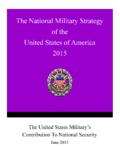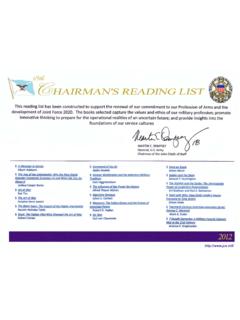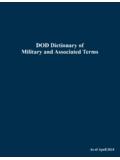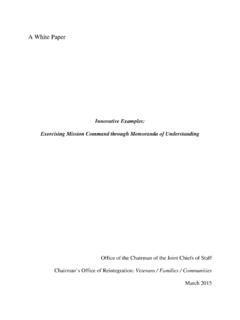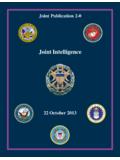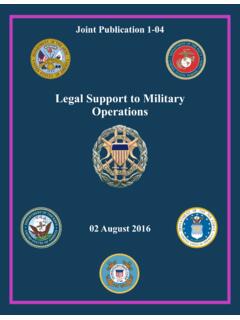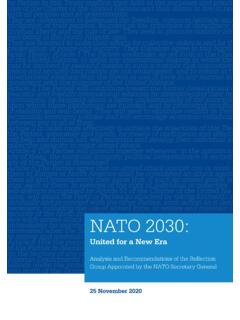Transcription of JP 3-27, Homeland Defense, 10 April 2018
1 DEPAOTMENTFTHEARMY EUNITEDSTATSOAFAMERICRTHISWE'LLDEFENDJ oint Publication 3-27 Homeland Defense10 April 2018 i PREFACE 1. Scope This publication provides joint doctrine for Homeland defense. 2. Purpose This publication has been prepared under the direction of the Chairman of the Joint Chiefs of Staff (CJCS). It sets forth joint doctrine to govern the activities and performance of the Armed Forces of the United States in joint operations, and it provides considerations for military interaction with governmental and nongovernmental agencies, multinational forces, and other interorganizational partners. It provides military guidance for the exercise of authority by combatant commanders and other joint force commanders (JFCs), and prescribes joint doctrine for operations and training.
2 It provides military guidance for use by the Armed Forces in preparing and executing their plans and orders. It is not the intent of this publication to restrict the authority of the JFC from organizing the force and executing the mission in a manner the JFC deems most appropriate to ensure unity of effort in the accomplishment of objectives. 3. Application a. Joint doctrine established in this publication applies to the Joint Staff, commanders of combatant commands, subordinate unified commands, joint task forces, subordinate components of these commands, the Services, and combat support agencies. b. The guidance in this publication is authoritative; as such, this doctrine will be followed except when, in the judgment of the commander, exceptional circumstances dictate otherwise.
3 If conflicts arise between the contents of this publication and the contents of Service publications, this publication will take precedence unless the CJCS, normally in coordination with the other members of the Joint Chiefs of Staff, has provided more current and specific guidance. Commanders of forces operating as part of a multinational (alliance or coalition) military command should follow multinational doctrine and procedures ratified by the United States. For doctrine and procedures not ratified by the US, commanders should evaluate and follow the multinational command s doctrine and procedures, where applicable and consistent with US law, regulations, and doctrine. For the Chairman of the Joint Chiefs of Staff: KEVIN D.
4 SCOTT Vice Admiral, USN Director, Joint Force Development Preface ii JP 3-27 Intentionally Blank iii SUMMARY OF CHANGES REVISION OF JOINT PUBLICATION 3-27 DATED 29 JULY 2013 Reorganizes Chapter I, Fundamentals of Homeland Defense, to describe Homeland security (HS), defense support of civil authorities (DSCA), and Homeland defense (HD) as a unified approach; adds more information on Department of Homeland Security s mission with respect to HS and the transregional, multi-domain, and multifunctional nature of the transnational threat environment; adds information on unmanned aircraft systems, global campaign plans, and incident awareness and assessment; updates laws, policies, and terminology; and enhances the succinctness of the chapter.
5 Adds information to Chapter II, Command Relationships and Interorganizational Cooperation, on unified action and properly defines United States Coast Guard s (USCG s) HD roles and the differences between maritime Homeland security (MHS) and maritime Homeland defense (MHD) tasks, as well as the required coordination between US Navy and USCG. Adds to Chapter II, Command Relationships and Interorganizational Cooperation, US Alaskan Command and removes Joint Task Force Alaska; clarifies US Pacific Command s role in HD and the MHD execute order; and updates terminology and references to other joint publications. Covers Chapter III, Planning and Operations for Homeland Defense, operations in all domains for Homeland defense; adds paragraph on MHS support to strategic sealift; aligns information operations as one of the seven joint functions; clarifies roles and responsibilities for Homeland ballistic missile defense; expands cyberspace operations and critical infrastructure protection; and moves joint reception, staging, onward movement, and integration verbiage to more pertinent location.
6 Updates Appendix A, Relationships Betweeen Homeland Security, Homeland Defense and Defense Support of civil Authorities, to reflect changes made by National Defense Authorization Act Fiscal Year 2017 and adds a more concise diagram depicting the relationship between HS, HD, and DSCA. Revises the explanation and mission of multiple interorganizational agencies within the United States Government in Appendix B, Facilitating Interorganizational Cooperation. Updates Appendix C, North American Aerospace Defense Command Missions, Organization, and Structure, definitions and provides for a more succinct document. Updates references used throughout the document and removes extraneous descriptors for Appendix D, References.
7 Summary of Changes iv JP 3-27 Intentionally Blank v TABLE OF CONTENTS EXECUTIVE SUMMARY .. vii CHAPTER I FUNDAMENTALS OF Homeland DEFENSE General .. I-1 I-4 Homeland Defense Policy and Legal Considerations .. I-5 Active, Layered Defense .. I-9 The Homeland Defense Operational Framework .. I-10 CHAPTER II COMMAND RELATIONSHIPS AND INTERORGANIZATIONAL COOPERATION General ..II-1 Unified Action ..II-1 Command and Control Relationships and Responsibilities ..II-3 Interagency Coordination ..II-16 Interorganizational Cooperation Considerations ..II-21 Multinational Forces ..II-21 CHAPTER III PLANNING AND OPERATIONS FOR Homeland DEFENSE General .. III-1 Strategic Guidance.
8 III-1 Operational Factors .. III-1 Intelligence Sharing for Homeland Defense .. III-3 Joint Fires .. III-4 Movement and Maneuver in the Conduct of Homeland Defense .. III-5 Protection .. III-19 Sustainment .. III-26 Other Activities and Efforts .. III-31 APPENDIX A Relationships Between Homeland Security, Homeland Defense, and Defense Support of Civil Authorities .. A-1 B Facilitating Interorganizational Cooperation ..B-1 C North American Aerospace Defense Command Missions, Organization, and Structure ..C-1 D Joint Task Force Headquarters Enabling Capabilities Points of Contact .. D-1 E References .. E-1 F Administrative Instructions .. F-1 Table of Contents vi JP 3-27 GLOSSARY Part I Abbreviations, Acronyms, and Initialisms.
9 GL-1 Part II Terms and Definitions .. GL-8 FIGURE I-1 Homeland Defense Transnational Threat Environment .. I-5 I-2 Guidance and Policy for the Intelligence Oversight Program .. I-7 II-1 United States Northern Command Homeland Defense Command Relationships ..II-7 II-2 Maritime Homeland Defense and Maritime Homeland Security Command Relationships ..II-9 III-1 Homeland Defense Land Operations Rapid Response Process .. III-7 III-2 Homeland Defense Land Operations Sustained Response Process .. III-9 A-1 Relationships Between Homeland Defense, Defense Support of Civil Authorities, and Homeland Security Missions .. A-2 vii EXECUTIVE SUMMARY COMMANDER S OVERVIEW Discusses fundamentals of Homeland defense (HD), to include threats; policy and legal considerations; active, layered defense; and the HD operational framework Describes command relationships and interorganizational cooperation in HD Outlines strategic guidance, operational factors, intelligence sharing, and joint functions considerations for planning and operations for Homeland defense Fundamentals of Homeland Defense The United States Government (USG) employs all instruments of national power to continuously detect, deter, prevent, and defeat threats to the Homeland .
10 This national imperative translates operationally into Homeland security (HS), defense support of civil authorities (DSCA), and Homeland defense (HD). The Department of Defense (DOD) is the lead federal agency (LFA) for defending against traditional external threats or aggression ( , nation-state conventional forces or weapons of mass destruction attack) and against external asymmetric threats that are outside of the scope of HS operations. The Department of Homeland Security (DHS) is the LFA for HS, and the United States Coast Guard (USCG) is the LFA for maritime Homeland security (MHS). By law, DOD is responsible for two missions in the Homeland : DSCA and HD. HD is the protection of US sovereignty, territory, domestic population, and critical infrastructure against external threats and aggression or other threats, as directed by the President of the US.

